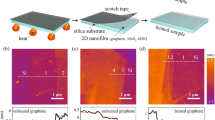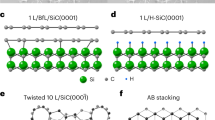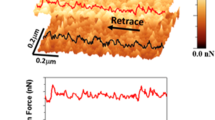Abstract
From the early tribological studies of Leonardo da Vinci to Amontons’ law, friction has been shown to increase with increasing normal load. This trend continues to hold at the nanoscale, where friction can vary nonlinearly with normal load1,2. Here we present nanoscale friction force microscopy (FFM) experiments for a nanoscale probe tip sliding on a chemically modified graphite surface in an atomic force microscope (AFM). Our results demonstrate that, when adhesion between the AFM tip and surface is enhanced relative to the exfoliation energy of graphite, friction can increase as the load decreases under tip retraction. This leads to the emergence of an effectively negative coefficient of friction in the low-load regime. We show that the magnitude of this coefficient depends on the ratio of tip–sample adhesion to the exfoliation energy of graphite. Through both atomistic- and continuum-based simulations, we attribute this unusual phenomenon to a reversible partial delamination of the topmost atomic layers, which then mimic few- to single-layer graphene. Lifting of these layers with the AFM tip leads to greater deformability of the surface with decreasing applied load. This discovery suggests that the lamellar nature of graphite yields nanoscale tribological properties outside the predictive capacity of existing continuum mechanical models.
This is a preview of subscription content, access via your institution
Access options
Subscribe to this journal
Receive 12 print issues and online access
$259.00 per year
only $21.58 per issue
Buy this article
- Purchase on Springer Link
- Instant access to full article PDF
Prices may be subject to local taxes which are calculated during checkout





Similar content being viewed by others
References
Derjaguin, B. V., Muller, V. M. & Toporov, Yu. P. Effect of contact deformations on the adhesion of particles. J. Colloid Interface Sci. 53, 314–326 (1975).
Johnson, K. L., Kendall, K. & Roberts, A. D. Surface energy and the contact of elastic solids. Proc. R. Soc. Lond. A 324, 301–313 (1971).
Prelas, G. A., Popovici, G. & Bigelow, L. K. Handbook of Industrial Diamonds and Diamond Films (Marcel Dekker, 1998).
Dresselhaus, M. S. & Dresselhaus, G. Intercalation compounds of graphite. Adv. Phys. 51, 1–186 (2002).
Geim, A. K. Graphene: Status and prospects. Science 324, 1530–1534 (2009).
Allen, M. J., Tung, V. C. & Kaner, R. B. Honeycomb carbon: A review of graphene. Chem. Rev. 110, 132–145 (2010).
Filleter, T. et al. Friction and dissipation in epitaxial graphene films. Phys. Rev. Lett. 102, 086102 (2009).
Filleter, T. & Bennewitz, R. Structural and frictional properties of graphene films on SiC(0001) studied by atomic force microscopy. Phys. Rev. B 81, 155412 (2010).
Lee, C. et al. Frictional characteristics of atomically thin sheets. Science 328, 76–80 (2010).
Dienwiebel, M. et al. Superlubricity of graphite. Phys. Rev. Lett. 92, 126101 (2004).
Lee, H., Lee, N., Seo, Y., Eom, J. & Lee, S. Comparison of frictional forces on graphene and graphite. Nanotechnology 20, 325701 (2009).
Marchon, B., Carrazza, J., Heinemann, H. & Somorjai, G. A. TPD and XPS studies of O2, CO2, and H2O adsorption on clean polycrystalline graphite. Carbon 26, 507–514 (1988).
Wang, S., Zhang, Y., Abidi, N. & Cabrales, L. Wettability and surface free energy of graphene films. Langmuir 25, 11078 (2009).
Socoliuc, A., Bennewitz, R., Gnecco, E. & Meyer, E. Transition from stick-slip to continuous sliding in atomic friction: Entering a new regime of ultralow friction. Phys. Rev. Lett. 92, 134301 (2004).
Lantz, M. A., O’Shea, S. J., Hoole, A. C. F. & Welland, M. E. Lateral stiffness of the tip and tip-sample contact in frictional force microscopy. Appl. Phys. Lett. 70, 970–972 (1996).
Carpick, R. W., Ogletree, D. F. & Salmeron, M. Lateral stiffness: A new nanomechanical measurement for the determination of shear strengths with friction force microscopy. Appl. Phys. Lett. 70, 1548–1550 (1997).
Dong, Y., Perez, D., Voter, A. F. & Martini, A. The roles of statics and dynamics in determining transitions between atomic friction regimes. Tribol. Lett. 42, 99–107 (2011).
Zacharia, R., Ulbricht, H. & Hertel, T. Interlayer cohesive energy of graphite from thermal desorption of polyaromatic hydrocarbons. Phys. Rev. B 69, 155406 (2004).
Hasegawa, M., Nishidate, K. & Iyetomi, H. Energetics of interlayer binding in graphite: The semiempirical approach revisited. Phys. Rev. B 76, 115424 (2007).
Spanu, L., Sorella, S. & Galli, G. Nature and strength of interlayer binding in graphite. Phys. Rev. Lett. 103, 196401 (2009).
Grierson, D. S., Flater, E. E. & Carpick, R. W. Accounting for the JKR–DMT transition in adhesion and friction measurements with atomic force microscopy. J. Adhesion Sci. Technol. 19, 291–311 (2005).
Mo, Y., Turner, K. T. & Szlufarska, I. Friction laws at the nanoscale. Nature 457, 1116–1119 (2009).
Smolyanitsky, A., Killgore, J. P. & Tewary, V. K. Effect of elastic deformation on frictional properties of few-layer graphene. Phys. Rev. B 85, 035412 (2012).
Acknowledgements
The authors thank F. Sharifi for providing invaluable insights regarding this work, and K. Steffens for XPS measurements. We further thank R. Carpick, C. Righi and J. Killgore for stimulating discussions. N. Faralli created the rendering software used to visualize the molecular dynamics simulations. Z.D. acknowledges support under the Cooperative Research Agreement between the University of Maryland and the National Institute of Standards and Technology Center for Nanoscale Science and Technology, Award 70NANB10H193, through the University of Maryland. This research was performed while A.S. held a National Research Council Postdoctoral Research Associateship at NIST. Q.L. and X-Q.F. acknowledge support from the National Natural Science Foundation of China (11272177), the Thousand Young Talents Program (20121770071) and the 973 Program 2010CB631005, 2012CB934101 and 2013CB933003.
Author information
Authors and Affiliations
Contributions
Z.D. performed the experiments. Z.D. and R.J.C. analysed the data. A.S. devised and performed the molecular dynamics simulations. Q.L. devised and performed the finite element simulations. X-Q.F. provided guidance for the FE simulations of Q.L. R.J.C. supervised the project. Z.D., A.S., Q.L. and R.J.C. discussed results, composed the manuscript, and contributed to revisions.
Corresponding author
Ethics declarations
Competing interests
The authors declare no competing financial interests.
Supplementary information
Supplementary Information
Supplementary Information (PDF 1300 kb)
Supplementary Information
Supplementary Movie S1 (AVI 5601 kb)
Supplementary Information
Supplementary Movie S2 (AVI 9887 kb)
Supplementary Information
Supplementary Movie S3 (AVI 9927 kb)
Supplementary Information
Supplementary Movie S4 (AVI 9951 kb)
Supplementary Information
Supplementary Movie S5 (AVI 9745 kb)
Rights and permissions
About this article
Cite this article
Deng, Z., Smolyanitsky, A., Li, Q. et al. Adhesion-dependent negative friction coefficient on chemically modified graphite at the nanoscale. Nature Mater 11, 1032–1037 (2012). https://doi.org/10.1038/nmat3452
Received:
Accepted:
Published:
Issue Date:
DOI: https://doi.org/10.1038/nmat3452
This article is cited by
-
Modulation mechanism of electron energy dissipation on superlubricity based on fluorinated 2D ZIFs
Nano Research (2024)
-
Friction hysteretic behavior of supported atomically thin nanofilms
npj 2D Materials and Applications (2023)
-
From ultra-low friction to superlubricity state of black phosphorus: Enabled by the critical oxidation and load
Friction (2023)
-
The Transition of Friction Coefficient on Graphene by the Microsphere Probe
Tribology Letters (2023)
-
Atomistic observation on diffusion-mediated friction between single-asperity contacts
Nature Materials (2022)



